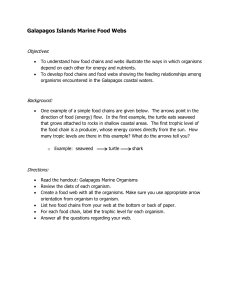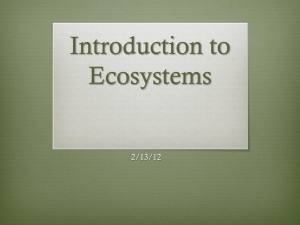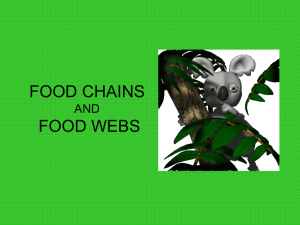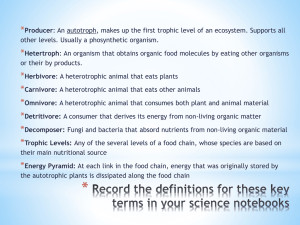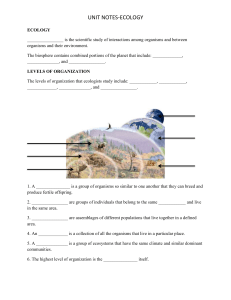1c Unit 10 Introduction_To_Food_Chains_And_Webs_
advertisement
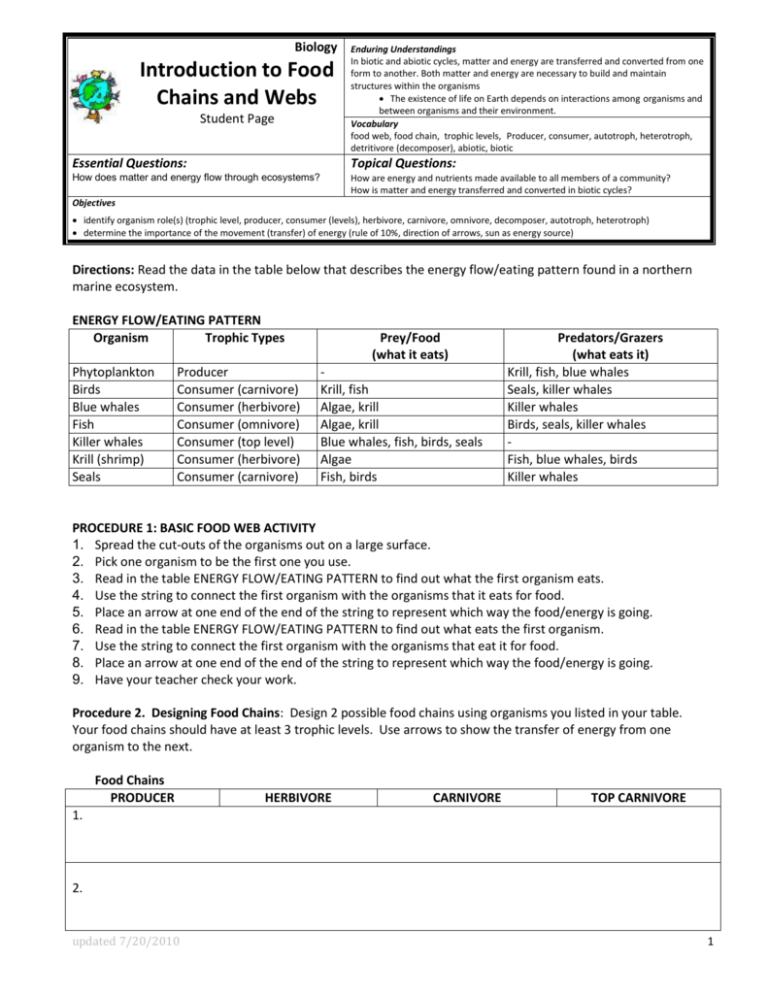
Biology Introduction to Food Chains and Webs Student Page Enduring Understandings In biotic and abiotic cycles, matter and energy are transferred and converted from one form to another. Both matter and energy are necessary to build and maintain structures within the organisms The existence of life on Earth depends on interactions among organisms and between organisms and their environment. Vocabulary food web, food chain, trophic levels, Producer, consumer, autotroph, heterotroph, detritivore (decomposer), abiotic, biotic Essential Questions: Topical Questions: How does matter and energy flow through ecosystems? How are energy and nutrients made available to all members of a community? How is matter and energy transferred and converted in biotic cycles? Objectives identify organism role(s) (trophic level, producer, consumer (levels), herbivore, carnivore, omnivore, decomposer, autotroph, heterotroph) determine the importance of the movement (transfer) of energy (rule of 10%, direction of arrows, sun as energy source) Directions: Read the data in the table below that describes the energy flow/eating pattern found in a northern marine ecosystem. ENERGY FLOW/EATING PATTERN Organism Trophic Types Phytoplankton Birds Blue whales Fish Killer whales Krill (shrimp) Seals Producer Consumer (carnivore) Consumer (herbivore) Consumer (omnivore) Consumer (top level) Consumer (herbivore) Consumer (carnivore) Prey/Food (what it eats) Krill, fish Algae, krill Algae, krill Blue whales, fish, birds, seals Algae Fish, birds Predators/Grazers (what eats it) Krill, fish, blue whales Seals, killer whales Killer whales Birds, seals, killer whales Fish, blue whales, birds Killer whales PROCEDURE 1: BASIC FOOD WEB ACTIVITY 1. Spread the cut-outs of the organisms out on a large surface. 2. Pick one organism to be the first one you use. 3. Read in the table ENERGY FLOW/EATING PATTERN to find out what the first organism eats. 4. Use the string to connect the first organism with the organisms that it eats for food. 5. Place an arrow at one end of the end of the string to represent which way the food/energy is going. 6. Read in the table ENERGY FLOW/EATING PATTERN to find out what eats the first organism. 7. Use the string to connect the first organism with the organisms that eat it for food. 8. Place an arrow at one end of the end of the string to represent which way the food/energy is going. 9. Have your teacher check your work. Procedure 2. Designing Food Chains: Design 2 possible food chains using organisms you listed in your table. Your food chains should have at least 3 trophic levels. Use arrows to show the transfer of energy from one organism to the next. Food Chains PRODUCER HERBIVORE CARNIVORE TOP CARNIVORE 1. 2. updated 7/20/2010 1 PROCEDURE 3: USING PATTERNS IN MAKING A FOOD WEB 1. Spread the cut-outs of the organism roles out, grouped by name. 2. Use the chart ROLES IN AN ECOSYSTEM (found below) for the definition of each role. 3. Look at your food web and place the matching role sort cards beside each organism. 4. Have your teacher check your work. ROLES IN AN ECOSYSTEM AUTOTROPH Organisms (plants) that can make their own food, mainly by photosynthesis; they are able to manufacture food from inorganic raw materials; PRODUCERS HETEROTROPH Organisms that cannot make their own food; they must eat other organisms for energy; CONSUMERS HERBIVORE Organisms that eat producers; PRIMARY CONSUMERS; GRAZERS CARNIVORE Organisms that eat other animals, including herbivores or other carnivores; SECONDARY CONSUMERS eat primary consumers, TERTIARY CONSUMERS eat secondary consumers, etc OMNIVORE Organisms that feed on both plants and animals PREDATOR Organism that hunts, kills and eats other organisms PREY Organism that is hunted, killed and eaten POST ACTIVITY DISCUSSION QUESTIONS Why did one organism in your food web not have any food (what it eats) listed for it? Why did one organism in your food web not have any predators (what eats it) listed for it? How did you decide on which end of the string to have your arrow point? What happens to these organisms when they die? updated 7/20/2010 2 Analysis Food chains and food webs show the flow of energy through an ecosystem. Food chains are linear depictions of energy flow, while food webs show the multiple interactions among the different types of organisms. Food webs are generally a more realistic portrayal of the energy flow in the system. After all, organisms eat more than one type of food and can be eaten by more than one type of predator. Each level of a food web or a food chain is called a trophic or feeding level. Organisms in the food web are classified by whether they are primary producers or consumers. The consumers in food webs are called heterotrophs and they consume the organic material made by autotrophs, also called producers. The fundamental energy source for food webs and food chains is the sun. Producers capture the sun’s radiant energy and convert it into chemical energy (food/organic compounds) through photosynthesis. The most energy in an ecosystem is available at the producer level. We are most familiar with plants and trees as producers. However, there are a substantial number of producers in the marine environment – most of which we cannot see without a microscope, the phytoplankton. Despite their small size, phytoplankton (primarily marine algae and cyanobacteria) are vital to marine food webs. DATA ANALYSIS 1. What is the starting point of all food chains/webs? Explain your answer. _______________________________ __________________________________________________________________________________________ 2. Describe the role of decomposers in the food web. Describe where the matter they break down goes. __________________________________________________________________________________________ 3. What types of organisms make up the lowest trophic level? __________________________________________ 4. What types of organisms make up the highest trophic level? 5. What would happen in a food chain if one organism were to die? ______________________________ ____________________________________________________________________________________ 6. What would happen in this food web if the all the birds were to die? ` ___________________________________ __________________________________________________________________________________________ 7. Which is more stable, a food chain or a food web? __________________________________________________ Why? PROCEDURE 3: ARRANGING ORGANISMS INTO AN EXISTING WEB 1. Study the Data Analysis Food Web (found on the last page of this document.) This web has the organisms arranged by trophic level. 2. Compare your web with the Data Analysis Food Web. Decide which organisms would fit into the positions shown by the lettered boxes and write their names in the box. (You can rearrange your web cutouts to match if you wish.) 3. Now list the correct roles for the organism in the dotted boxes associated with each organism. ANSWER THESE QUESTIONS AFTER COMPLETING THE DATA ANALYSIS FOOD WEB. 1. What helped you most to decide which organism went into each lettered box? 2. Why must the arrows point in a certain direction in a food web? 3. What is the rule to know which way to point the arrow? updated 7/20/2010 3 4. Explain how an organism can have more than one role in an ecosystem. 5. Blue Whales are the biggest animals that have ever lived on the face of the earth. How can such a huge animal survive eating tiny phytoplankton? updated 7/20/2010 4 Trophic Level 1 Producers Trophic Level 2 1st Consumer Herbivores Trophic Level 3 2nd Consumer Carnivores Omnivores Trophic Level 5 4th Consumer Carnivores B Trophic Level 4 3rd Consumer Carnivores DATA ANALYSIS FOOD WEB: (6 roles) A D (2 roles) updated 7/20/2010 (4 roles) F C (6 roles) (5 roles) G (5 roles) (4 roles) E 5


